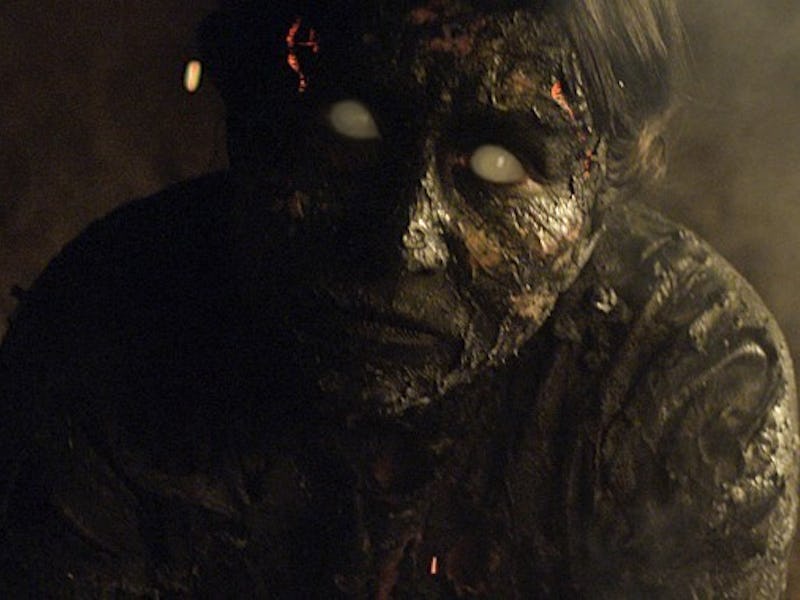What We Learned From 2015's Horror Movies
'Bone Tomahawk,' 'It Follows,' and 'Crimson Peak' taught us we need fewer laughs, and more auteurs.

2015 will be remembered as the year horror filmmakers finally caught up to savvier, more discerning audiences. In a market oversaturated with stale Jason Blum franchises — Insidious, The Purge, Sinister, and Paranormal Activity all lumbered forward this year — filmmakers had to innovate in order to shine through. Many delivered; here’s how.
Genre blending
Perhaps making horror hybrids keeps audiences on their toes, unable to guess what trope might inform a film’s next move. Bone Tomahawk, this year’s runaway cult hit, begins like any American western film your dad would watch on Turner Classic Movies at 2 p.m. Suddenly, Kurt Russell has a bone shaft jammed into his mouth and everything goes to hell. The film crescendoes in what some critics are calling “the most brutal death scene in cinematic history”, solidifying its role as a gut-churning horror-western.
The Nightmare pulled off being both a documentary on sleep paralysis and a horror film about illusion and paranoia. Crimson Peak was a classically stylized Gothic romance and Maggie was a generational drama dressed up like a zombie film, although it worked in both ways. The Irish and British Let Us Prey was the genre-hybrid juggernaut of the year, somehow succeeding as a dark comedy, cop drama, high fantasy, horror film on religion. Clearly, there is something to be said for borrowing from other genres to make a horror film memorable.
Immersive mise en scène
2015 was also a year of gorgeous, lush horror films, partially because Guillermo Del Toro returned to pop culture relevance (post-The Strain) in a flurry of silk. Crimson Peak, though not the scariest film of the year, was almost relentless in style. Del Toro’s ghosts were highly saturated red, his villains were dressed in matching satin formalwear, and his final showdown was set in a snowy void, the only color being Mia Wasikowska’s hair and the spray of blood. There is no mistaking a frame from Crimson Peak as being from any other film.
Of course, mise en scène doesn’t always have to be as loud as Del Toro would have us believe. It Follows enjoyed a wider release this summer, and was arguably one of the most beautiful films of the year, across all genres. Its buzzing, ominous score framed shots which weren’t afraid to linger. The entire film, while being deeply disturbing, was a pastel, muted ode to teenage summer.
The Austrian horror Goodnight Mommy was widely released in 2015 and delighted fans of the arthouse genre. Twin boys, a largely silent mother wrapped in gauze and a sterile, modern-looking house all added to the film’s potent sense of dread. Other 2015 horror films notable for their unique visual rhetoric include The Hallow, an Irish film, and Creep, which managed to squeak one last success out of the found-footage-style camcorder genre.
Subversion of tropes
The current horror audience is the most informed and well-versed in tropes the genre has ever seen. Now that horror is mainstream, any one of us could probably out-trivia Drew Barrymore’s character in Scream, and this means filmmakers can’t peddle the same plot-lines out again and again. Though a horror film can’t survive solely on jump scares anymore, it can please contemporary audiences by reversing, or at least playing around with, horror tropes.
It Follows interrogated teen sexuality in horror, and We Are Still Here told the story of a middle-aged couple after their son’s sudden death. The latter, though a pretty straight-forward haunted house film, was enjoyable purely because of its unique lead characters.
A Tip: Ease up on the humor
We learned in 2015 that subverting genre tropes does not have to mean lampooning them. In fact, films like It Follows were so gentle in their sendup of the genre’s contemporary output that horror comedies like The Final Girls look clumsy, and even garish in comparison. Cooties was a flop, Krampus disappointed, and The Visit was arguably the worst film of the year.
2015 was a grim year for horror, meaning the stand-out films were not comedy hybrids, but were deadly serious art films instead. In recent years, some of the most exciting work in horror was influenced by comedy — one recalls Shaun of the Dead, Tucker and Dale vs Evil, Housebound, and What We Do in the Shadows — but it appears those days are over for now. The best horror films of 2015 were fun without relying on jokes; the joy in watching them rests in a respect for what fear can do. Next year’s films will do well to take note.